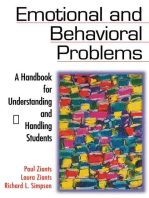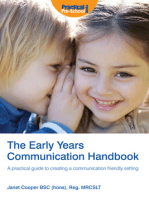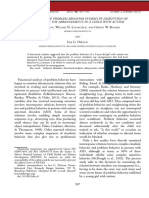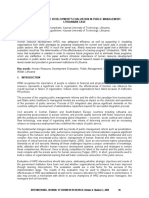Overview of Pivotal Response Training (PRT)
Overview of Pivotal Response Training (PRT)
Uploaded by
Otto F OttOCopyright:
Available Formats
Overview of Pivotal Response Training (PRT)
Overview of Pivotal Response Training (PRT)
Uploaded by
Otto F OttOOriginal Description:
Original Title
Copyright
Available Formats
Share this document
Did you find this document useful?
Is this content inappropriate?
Copyright:
Available Formats
Overview of Pivotal Response Training (PRT)
Overview of Pivotal Response Training (PRT)
Uploaded by
Otto F OttOCopyright:
Available Formats
National Professional Development Center on
Autism Spectrum Disorders
Module: Pivotal Response Training (PRT)
Overview of Pivotal Response Training (PRT)
Vismara, L.A., & Bogin, J. (2009). Steps for implementation: Pivotal response training.
Sacramento, CA: The National Professional Development Center on Autism Spectrum
Disorders, The M.I.N.D. Institute, The University of California at Davis School of
Medicine.
Pivotal Response Training (PRT) is a method of systematically applying the scientific principles
of applied behavior analysis (ABA) to teach learners with autism spectrum disorders (ASD).
PRT builds on learner initiative and interests, and is particularly effective for developing
communication, language, play, and social behaviors. PRT was developed to create a more
efficient and effective intervention by enhancing four pivotal learning variables: motivation,
responding to multiple cues, self-management, and self-initiations. According to theory, these
skills are pivotal because they are the foundational skills upon which learners with ASD can
make widespread and generalized improvements in many other areas.
Evidence
PRT meets the criteria for an evidence-based practice with nine single subject design studies
supporting its teaching practices. PRT constitutes an efficient and effective mode of intervention
for promoting appropriate social communicative and adaptive behavior for children at the
preschool and elementary school levels and for adolescents and young adults at the middle and
high school level.
With what ages is PRT effective?
According to the studies that form the evidence base for PRT, children from 2 to 16 years of age
have benefitted from PRT intervention. Research has shown that the use of motivational
techniques inside PRT’s teaching framework can lead to 85-90% of children with autism, who
begin intervention before the age of 5, developing verbal communication as a primary mode of
communication. More recently, though, researchers have identified specific behavioral
characteristics associated with favorable responses to the teaching practices. Precursors
related to positive outcomes thus far, include increased use of social initiations, less social
avoidance, more toy play, and stereotypic language.
What skills or intervention goals can be addressed with PRT?
The focus of PRT is to teach children and youth with ASD certain pivotal behaviors through a
set of specific training procedures, which, when learned, will lead to the development of new
behaviors. The pivotal behaviors targeted in PRT are: motivation, responding to multiple cues,
self-management, and self-initiations. By acquiring these behaviors children can learn skills in
the areas of academics, social, language/communication, and self management. Improvements
in these areas will promote a variety of social-communicative behaviors, such as
communication, imitation, play skills, joint attention, and will reduce inappropriate, maladaptive
behaviors.
Pivotal Response Training: Overview Page 1 of 4
National Professional Development Center on ASD
10/2010
National Professional Development Center on
Autism Spectrum Disorders
Module: Pivotal Response Training (PRT)
In what settings can PRT be effectively used?
The ultimate goal of PRT is to provide learners with autism with the social and educational skills
to participate independently in enriched and meaningful lives in inclusive settings. PRT
emphasizes the importance of training parents as primary intervention agents; however, other
family members (e.g., siblings, secondary caregiver), staff (e.g., teachers, school personnel,
consultants), and typically developing peers are also included as intervention agents. As a
result, PRT has been successfully implemented in a variety of naturalistic settings, including
school, home, and community. Further, teaching in varied and more naturalistic environments
has been demonstrated to promote generalization of skills.
Evidence Base
The studies cited in this section document that this practice meets the NPDC on ASD’s criteria
for an evidence-based practice. This list is not exhaustive; other quality studies may exist that
were not included.
Preschool
Jones, E. A., Carr, E. G., & Feeley, K. M. (2006). Multiple effects of joint attention intervention
for children with autism. Behavior Modification, 30, 782-834.
Koegel, R. J. L., Camarate, S., Koegel, L. K., Bea-Tall, A., & Smith, A. E. (1998) Increasing
speech intelligibility in children with autism. Journal of Autism and Developmental
Disorders, 28(3), 241-251.
Koegel, R. L., Dyer, K., & Bell, L. K. (1987). The influence of child preferred activities on autistic
children’s speech behavior. Journal of Applied Behavioral Analysis, 20, 243-252.
Koegel, R. L., Koegel, L. K. , Surrat, A. (1992). Language intervention and disruptive behavior in
preschool children with autism. Journal of Autism and Developmental disorders, 22(2),
141-153
Stahmer, A. C. (1995). Teaching symbolic play skills to children with autism using pivotal
response treatment. Journal of Autism and Developmental Disorders, 25, 123-141.
Whalen, C., & Schreibman, L. (2003). Joint attention training for children with autism using
behavior modification procedures. Journal of Child Psychology & Psychiatry, 44(3), 456-
468.
Elementary
Koegel, R. J. L., Camarate, S., Koegel, L. K., Bea-Tall, A., & Smith, A. E. (1998). Increasing
speech intelligibility in children with autism. Journal of Autism and Developmental
Disorders, 28(3), 241-251.
Pivotal Response Training: Overview Page 2 of 4
National Professional Development Center on ASD
10/2010
National Professional Development Center on
Autism Spectrum Disorders
Module: Pivotal Response Training (PRT)
Koegel, R. L., Dyer, K., & Bell, L. K. (1987). The influence of child preferred activities on autistic
children’s speech behavior. Journal of Applied Behavioral Analysis, 20, 243-252.
Pierce, K., & Schreibman, L. (1997). Multiple peer use of pivotal response training to increase
social behaviors of classmates with autism: results from trained and untrained peers.
Journal of Applied Behavioral Analysis, 30, 157-160.
Thorp, D. M., Stahmer, A. C. & Schreibman, L. (1995). Effects of sociodramatic play training on
children with autism. Journal of Autism and Developmental Disorders, 25, 265-282.
Middle/High School
Koegel, R. L., Dyer, K., & Bell, L. K. (1987). The influence of child preferred activities on autistic
children’s speech behavior. Journal of Applied Behavioral Analysis, 20, 243-252.
Koegel, R. L. & Frea, W. D. (1993). Treatment of social behavior in autism through the
modification of pivotal social skills. Journal of Applied Behavior Analysis, 26, 369-377.
Additional References
Dibley, S., & Lim, L. (1999). Providing choice making opportunities within and between daily
school routines. Journal of Behavioral Education, 9(2), 117-132.
Dunlap, L.K., Dunlap. G., Koegel, L. K., & Koegel, R. L. (1991). Using self-monitoring to
increase independence. Teaching Exceptional Children, 23, 17-22.
Dunlap, G., & Koegel, R. L. (1980). Motivating autistic children through stimulus variation.
Journal of Applied Behavior Analysis, 13, 619-627.
Koegel, L. K., Carter, C. M., & Koegel, R. L. (2003). Teaching children with autism self-initiations
as a pivotal response. Topics in Language Disorders, 23(2), 134-145.
Koegel, L. K., Koegel, R. L., Harrower, J. K., & Carter, C. M. (1999). Pivotal response
intervention I: Overview of approach. Journal of Association for Persons with Severe
Handicaps, 24(3), 174-185.
Koegel, R. L., & Koegel, L. K. (2006). Pivotal response treatments for autism: Communication,
social, and academic development. Baltimore: Brookes Pub. Co.
Koegel, R. L., Koegel, L. K., & McNerney, E. K. (2001). Pivotal areas in intervention for autism.
Journal of Clinical Child Psychology, 30, 19-32.
Koegel, R. L., Openden, D., Fredeen, R., & Koegel, L. K. (2006). The basics of pivotal response
treatment. In R.L. Koegel and L.K. Koegel (Eds.) Pivotal Response Treatments for
Autism: Communication, Social, & Academic Development, (pp. 3-30). Baltimore:
Brookes Publishing.
Pivotal Response Training: Overview Page 3 of 4
National Professional Development Center on ASD
10/2010
National Professional Development Center on
Autism Spectrum Disorders
Module: Pivotal Response Training (PRT)
Koegel, R. L., Schreibman, L., Good, A., Cerniglia, L., Murphy, C., & Koegel, L. K. (1987). How
to teach pivotal behaviors to children with autism: A training manual. Santa Barbara, CA:
University of California.
Schreibman, L., & Koegel, R. L. (2005). Training for parents of children with autism: Pivotal
responses, generalization, and individualization of intervention. In E.D. Hibbs & P.S.
Jensen (Eds.) Psychological treatments for child and adolescent disorders: Empirically
based strategies for clinical practice (2nd edition), (pp. 603-631). Washington, DC:
American Psychological Association.
Pivotal Response Training: Overview Page 4 of 4
National Professional Development Center on ASD
10/2010
You might also like
- 610 FBA TemplateDocument13 pages610 FBA TemplateKate StebbinsNo ratings yet
- ABA in ClassroomDocument4 pagesABA in ClassroomSonia AssuncaoNo ratings yet
- Burns Anxiety InventoryDocument1 pageBurns Anxiety InventoryTeresa Meehan100% (2)
- Practical Functional Assessment and Treatment Notebook: (Revised: March, 2018) by Gregory P. Hanley, PH.D., BCBA-DDocument15 pagesPractical Functional Assessment and Treatment Notebook: (Revised: March, 2018) by Gregory P. Hanley, PH.D., BCBA-DDaniela Gerônimo100% (1)
- Abllsr Label PDFDocument31 pagesAbllsr Label PDFAnonymous 1HGqtl7100% (1)
- Women's Language and ConfidenceDocument20 pagesWomen's Language and ConfidenceAbit100% (2)
- Interventions for Autism: Evidence for Educational and Clinical PracticeFrom EverandInterventions for Autism: Evidence for Educational and Clinical PracticeNo ratings yet
- Supporting Students with Communication Disorders. A Collaborative Approach: A Resource for Speech-Language Pathologists, Parents and EducatorsFrom EverandSupporting Students with Communication Disorders. A Collaborative Approach: A Resource for Speech-Language Pathologists, Parents and EducatorsNo ratings yet
- Factors Related to Aggressive Behaviors in Adolescents with Autism Spectrum DisorderFrom EverandFactors Related to Aggressive Behaviors in Adolescents with Autism Spectrum DisorderNo ratings yet
- Emotional and Behavioral Problems: A Handbook for Understanding and Handling StudentsFrom EverandEmotional and Behavioral Problems: A Handbook for Understanding and Handling StudentsNo ratings yet
- The Early Years Communication Handbook: A practical guide to creating a communication friendly settingFrom EverandThe Early Years Communication Handbook: A practical guide to creating a communication friendly settingNo ratings yet
- Educational Strategies for Children With Autism Spectrum DisordersFrom EverandEducational Strategies for Children With Autism Spectrum DisordersNo ratings yet
- Recognizing and Addressing Autism Spectrum Disorders in Toddlers: A Comprehensive Guide for Teachers and Parents of Young Children with Sensory Processing Disorder (Spd) and Autism Spectrum Disorder (Asd)From EverandRecognizing and Addressing Autism Spectrum Disorders in Toddlers: A Comprehensive Guide for Teachers and Parents of Young Children with Sensory Processing Disorder (Spd) and Autism Spectrum Disorder (Asd)No ratings yet
- Managing the Cycle of Meltdowns for Students with Autism Spectrum DisorderFrom EverandManaging the Cycle of Meltdowns for Students with Autism Spectrum DisorderRating: 5 out of 5 stars5/5 (1)
- Chapter 11 SAFMEDS: What Is "Stimulus" Control?Document3 pagesChapter 11 SAFMEDS: What Is "Stimulus" Control?Taylor100% (1)
- Implementation of A BCBA Training Tract Within A LEND Program (Torri Smith Tejral)Document1 pageImplementation of A BCBA Training Tract Within A LEND Program (Torri Smith Tejral)AUCDNo ratings yet
- Toilet Training PresentationDocument20 pagesToilet Training PresentationSunshine Corliss Valdilles100% (1)
- ABA Visual Packet v6.1Document121 pagesABA Visual Packet v6.1khola.ayubNo ratings yet
- Transfer ProceduresDocument4 pagesTransfer ProceduresSorina VlasceanuNo ratings yet
- Ritualistic PlayDocument5 pagesRitualistic PlayArlene AmorimNo ratings yet
- Presentation PDFDocument130 pagesPresentation PDFcharraf55No ratings yet
- Tantrums Associated With Transitions in Preschool KidsDocument5 pagesTantrums Associated With Transitions in Preschool KidsMariaNo ratings yet
- Aba 2008 Ablls Poster 2 HandoutDocument9 pagesAba 2008 Ablls Poster 2 HandoutAgnesNo ratings yet
- FBA BIP Template With ExplanationsDocument2 pagesFBA BIP Template With ExplanationsjstncortesNo ratings yet
- HandoutsDocument43 pagesHandoutsAna Luiza Ferreira100% (1)
- 04-05 - Milestones Master Chart:VB-MAPP Scoring Forms 8/29/08 2:57 PM Page 4Document2 pages04-05 - Milestones Master Chart:VB-MAPP Scoring Forms 8/29/08 2:57 PM Page 4Quel PaivaNo ratings yet
- PairingDocument4 pagesPairingsimsoboth169100% (1)
- The Big Four Functional AssessmentDocument13 pagesThe Big Four Functional AssessmentMayla Diniz NevesNo ratings yet
- Verbal RequestingDocument2 pagesVerbal Requestingsimsoboth169No ratings yet
- Tip Sheet: Functional Behavior Assessment and Function-Based InterventionsDocument8 pagesTip Sheet: Functional Behavior Assessment and Function-Based InterventionsMei MeiNo ratings yet
- ABC Continuous Recording ModelDocument1 pageABC Continuous Recording ModelSudhakar PrasannaNo ratings yet
- FA Review, Hanley PDFDocument19 pagesFA Review, Hanley PDFNBNo ratings yet
- Why Is Joint Attention A Pivotal Skill in AutismDocument11 pagesWhy Is Joint Attention A Pivotal Skill in AutismFernanda Dantas100% (1)
- Increasing Mands PDFDocument12 pagesIncreasing Mands PDFPamelaLiraNo ratings yet
- Free Resources Aba UpdateDocument1 pageFree Resources Aba UpdateAmal100% (1)
- EFL-OverviewNew3PP (Essential For Liviving) PDFDocument28 pagesEFL-OverviewNew3PP (Essential For Liviving) PDFThayná RochaNo ratings yet
- Reinforcer Assessment PDFDocument3 pagesReinforcer Assessment PDFJhan Franco Tejada FloresNo ratings yet
- Problem Behavior Interventions For Young Children With Autism: A Research SynthesisDocument25 pagesProblem Behavior Interventions For Young Children With Autism: A Research Synthesiseebook123456No ratings yet
- Data Recording: o o o o o o o o oDocument8 pagesData Recording: o o o o o o o o oSwetha CNo ratings yet
- Fba PT 1Document11 pagesFba PT 1api-454885774No ratings yet
- EFL ReportTemplateProgressDocument3 pagesEFL ReportTemplateProgressJamieNo ratings yet
- Fritz Et Al. (2017)Document10 pagesFritz Et Al. (2017)Lai SantiagoNo ratings yet
- Attention Program: # 1 Count and Mand (Use When Problem Behavior Has Already Occurred)Document3 pagesAttention Program: # 1 Count and Mand (Use When Problem Behavior Has Already Occurred)Maria Celeste BlazquezNo ratings yet
- Self Care Checklist PDFDocument5 pagesSelf Care Checklist PDFuyoh ajaNo ratings yet
- Reinforcer When Presented in An Array of 2 For 5 Different Reinforcers (E)Document21 pagesReinforcer When Presented in An Array of 2 For 5 Different Reinforcers (E)Ana Luiza100% (1)
- Cengher, Bowman, Shawler, & Ceribo-Singh (2022) Mands For InformationDocument23 pagesCengher, Bowman, Shawler, & Ceribo-Singh (2022) Mands For InformationJohnNo ratings yet
- Carbone, Morgenstern, Zecchin-Tirri e KolbergDocument23 pagesCarbone, Morgenstern, Zecchin-Tirri e KolbergLeana BernardesNo ratings yet
- Effective Remote Staff Training of Objective Session NotesDocument13 pagesEffective Remote Staff Training of Objective Session NotesNBNo ratings yet
- Can The Early Start Denver Model Be Considered ABA PracticeDocument10 pagesCan The Early Start Denver Model Be Considered ABA PracticeLuis SeixasNo ratings yet
- VB MAPP Interpretation - HandoutDocument7 pagesVB MAPP Interpretation - HandoutNooraladarbh7No ratings yet
- Natural Environment Teaching Reading 3Document20 pagesNatural Environment Teaching Reading 3Danielle RodriguezNo ratings yet
- Registered Behavior: Technician CourseDocument34 pagesRegistered Behavior: Technician CourseMonika RežićNo ratings yet
- Sample Data - FFCDocument2 pagesSample Data - FFCCamyDelia100% (1)
- Bip Final 1 2 1Document4 pagesBip Final 1 2 1api-356299533No ratings yet
- My BCBA Study PlanDocument3 pagesMy BCBA Study PlanMohamed ElgendyNo ratings yet
- Abllsr JDocument3 pagesAbllsr JelutafNo ratings yet
- InTech-Applied Behavior Analysis Teaching Procedures and Staff Training For Children With AutismDocument23 pagesInTech-Applied Behavior Analysis Teaching Procedures and Staff Training For Children With AutismGarcía AndrésNo ratings yet
- Handling Behavior Problems in The Home and in The Community: by Mark L. Sundberg, PH.D., BCBA and Cindy A. SundbergDocument18 pagesHandling Behavior Problems in The Home and in The Community: by Mark L. Sundberg, PH.D., BCBA and Cindy A. SundbergLeana BernardesNo ratings yet
- Student Binder Protocol ChecklistDocument1 pageStudent Binder Protocol Checklistarlene ABANo ratings yet
- Gould - 2011 - Review of Assessments For EIBIDocument13 pagesGould - 2011 - Review of Assessments For EIBISJMothraNo ratings yet
- BehaviorismDocument9 pagesBehaviorismJie FranciscoNo ratings yet
- Beth's Behavior Intervention Plan: GoalDocument2 pagesBeth's Behavior Intervention Plan: GoalJéssica Coelho100% (1)
- The Importance of SAT and IST in Mission Critical FacilitiesDocument6 pagesThe Importance of SAT and IST in Mission Critical FacilitiesOtto F OttONo ratings yet
- Overview of Pivotal Response Training (PRT)Document4 pagesOverview of Pivotal Response Training (PRT)Otto F OttONo ratings yet
- Summary of Biomedical Treatments For Autism: by James B. Adams, PH.DDocument28 pagesSummary of Biomedical Treatments For Autism: by James B. Adams, PH.DOtto F OttONo ratings yet
- Go Its Application DevelopmentDocument26 pagesGo Its Application DevelopmentOtto F OttONo ratings yet
- OSS NG DatasheetDocument2 pagesOSS NG DatasheetOtto F OttONo ratings yet
- DefinitionDocument2 pagesDefinitionOtto F OttONo ratings yet
- OodmetrcDocument8 pagesOodmetrcOtto F OttONo ratings yet
- Patterns For Model-Driven Software-DevelopmentDocument50 pagesPatterns For Model-Driven Software-DevelopmentOtto F OttONo ratings yet
- Brief Composition: Review in No More Than 200 Words. Submit Your Composition Through This PeerDocument2 pagesBrief Composition: Review in No More Than 200 Words. Submit Your Composition Through This PeerEng-Mukhtaar CatooshNo ratings yet
- The Rule of Ethics: Organizations in EquilibriumDocument1 pageThe Rule of Ethics: Organizations in EquilibriumPatrick Ryan RamientoNo ratings yet
- Measuring CreativityDocument30 pagesMeasuring Creativityamitkumarpandole92% (12)
- Narcissistic Abuse From Victim To Survivor in 6 StepsDocument14 pagesNarcissistic Abuse From Victim To Survivor in 6 Stepscercuri pătrate de fumNo ratings yet
- Daily Lesson Plan - Science Year 6 (SDP)Document10 pagesDaily Lesson Plan - Science Year 6 (SDP)hellowuNo ratings yet
- Psych Testing Practice TestDocument7 pagesPsych Testing Practice Testcaleb castilloNo ratings yet
- Pres. Quirino Treasured Child School, Inc.: Prk. Capilar, Pob., President Quirino, Sultan KudaratDocument16 pagesPres. Quirino Treasured Child School, Inc.: Prk. Capilar, Pob., President Quirino, Sultan KudaratBaby Zahra BalubuganNo ratings yet
- Inbound 2795741670973065360Document16 pagesInbound 2795741670973065360sbrushNo ratings yet
- Shortcuts Used in Forming Impressions of OthersDocument8 pagesShortcuts Used in Forming Impressions of OthersMarjon DimafilisNo ratings yet
- PSY101 Chapter 3 AssignmentDocument5 pagesPSY101 Chapter 3 Assignmentnouraamn5No ratings yet
- Characteristics of Active Leadership (Trespeces, 2003)Document3 pagesCharacteristics of Active Leadership (Trespeces, 2003)John Vincent D. ReyesNo ratings yet
- Problems Encountered by Office Administration Students in Camarines Norte State College Amidst PandemicDocument15 pagesProblems Encountered by Office Administration Students in Camarines Norte State College Amidst PandemicChristine LaurencianoNo ratings yet
- Sahil AdeemDocument3 pagesSahil Adeemhannan.mujtabaNo ratings yet
- Documentary Film WorksheetDocument3 pagesDocumentary Film WorksheetDavid Velez Gonzalez100% (1)
- How A Food Addiction DevelopsDocument6 pagesHow A Food Addiction DevelopshopeIshanzaNo ratings yet
- Childlessness - How Not Having Children Plays Out Over A Lifetime, by Jerome LevinDocument68 pagesChildlessness - How Not Having Children Plays Out Over A Lifetime, by Jerome LevinwyhisoNo ratings yet
- Hallucinations Rating Scale - SAMPLEDocument3 pagesHallucinations Rating Scale - SAMPLETauqeer AhmedNo ratings yet
- "Incident" by Countee CullenDocument1 page"Incident" by Countee CullenDmitriy PautovNo ratings yet
- Chapter1 EBLDocument12 pagesChapter1 EBLMariana FerrarelliNo ratings yet
- A Validation Program For The Self-Beliefs, Writing-Beliefs, and Attitude SurveyDocument15 pagesA Validation Program For The Self-Beliefs, Writing-Beliefs, and Attitude SurveyJohnny WenNo ratings yet
- Course Syllabus in Purposive CommunicationDocument14 pagesCourse Syllabus in Purposive CommunicationMarkAnthonyLopezNo ratings yet
- Do Psychologists Still Listen To Freud CNNDocument4 pagesDo Psychologists Still Listen To Freud CNNJosé SilvaNo ratings yet
- Exploring The Teacher Experience: A Phenomenological Inquiry Into DepEd's Drop-Everything-And-Read (DEAR) ProgramDocument12 pagesExploring The Teacher Experience: A Phenomenological Inquiry Into DepEd's Drop-Everything-And-Read (DEAR) ProgramPsychology and Education: A Multidisciplinary JournalNo ratings yet
- Human Resource Development's Evaluation in Public ManagementDocument9 pagesHuman Resource Development's Evaluation in Public ManagementKelas KP LAN 2018No ratings yet
- Cs8079 - Hci QB Unit 3Document24 pagesCs8079 - Hci QB Unit 3Ramesh KumarNo ratings yet
- Similarities Between Conceptions of Cosmic Force in African and Chinese Philosophies and The Fiction of Philip Pullman and K.j.parkerDocument2 pagesSimilarities Between Conceptions of Cosmic Force in African and Chinese Philosophies and The Fiction of Philip Pullman and K.j.parkerToyin AdepojuNo ratings yet
- The Effects of Pornography On Individuals, Marriage, Family, and CommunityDocument26 pagesThe Effects of Pornography On Individuals, Marriage, Family, and CommunityElena RainbowNo ratings yet
- Ed Tech ECDE Activity PlanDocument3 pagesEd Tech ECDE Activity PlanBrina WilsonNo ratings yet

































































































